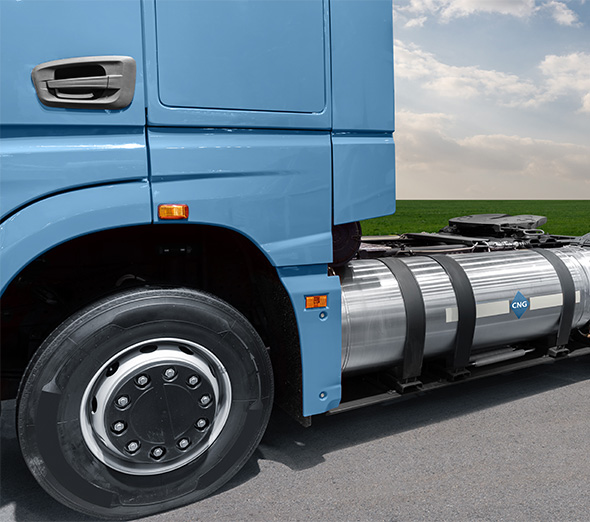| View in browser > |
 |
|
Welcome to National Grid’s Tips of the Trade for first responders. These tips are intended to help you respond safely and effectively to incidents involving natural gas and electricity. Please review them with your team.
|
|
| CNG vehicle fires |
|
 |
| Compressed natural gas (CNG) powers thousands of vehicles on our roads – from transit buses and sanitation trucks to semi‑trucks and passenger cars. Here's how to identify CNG vehicles and safely handle fires involving them. |
|
|
|
|
| Identifying CNG vehicles |
| CNG is stored in cylinders on the vehicle roof (common on buses), behind the cab, at the tailgate or along the sides of a vehicle. All CNG‑fueled vehicles must display a blue, diamond‑shaped “CNG” decal at the rear of the vehicle; decals on a vehicle’s front and sides are optional. |
|
 |
| Responding to CNG vehicle fires |
| When arriving at a CNG vehicle fire, always wear full PPE and SCBA. Establish a safe perimeter of at least 100 feet around the vehicle. Position apparatus upwind when possible. |
| CNG cylinders are protected with temperature‑activated pressure‑relief devices (PRDs) at one or both ends. PRDs will open and vent gas when the cylinder’s internal temperature reaches between 212°F and 220°F. |
As part of your size‑up, communicate with the driver to determine cylinder location. If fire is impinging on CNG cylinders, if cylinders are on fire or if the fire is fueled by an active CNG leak, take these steps: |
| • |
 |
DO NOT approach the vehicle. |
|
| • |
 |
Remain alert for PRD activation and a resulting jet flame. The flame may extend up to 50 feet in any direction. PRDs do not reset, so this flame may go out and re‑ignite several times. |
|
| • |
 |
Allow the fire to burn off until the gas is fully discharged and flames are no longer visible. This can take up to 30 minutes. |
|
| • |
 |
While the fire burns, watch for secondary hazards and protect exposures. |
|
| • |
 |
DO NOT apply water to CNG cylinders! Applying water will prevent PRDs from activating and could cause cylinders to rupture. |
|
| • |
 |
When flames have subsided, approach the vehicle at a 45‑degree angle only – never from the front or rear. Be prepared for possible cylinder re‑ignition. |
|
| • |
 |
When it is safe to do so, chock the vehicle’s wheels to prevent movement. |
|
| • |
 |
Inform towing and storage personnel that the vehicle is CNG‑fueled. |
|
| |
|
If CNG cylinders are not involved in the fire, first confirm cylinder locations with the driver, then approach the vehicle at a 45‑degree angle and proceed with normal extinguishment tactics. Remain alert for cylinder involvement. |
| For more first responder safety information, visit firstresponder.ngridsafety.com. |
|
|
|
| |
To report emergencies, call 911 and National Grid immediately.
Always call 911 if you suspect a gas leak! |
| |
|
To report emergencies, call 911 and National Grid immediately.
Always call 911 if you suspect a gas leak! |
 |
| In case of gas emergencies: |
 |
Long Island and the Rockaways:
911 and 1‑800‑490‑0045 |
 |
Metro New York:
911 and 1‑718‑643‑4050 |
 |
Upstate New York:
911 and 1‑800‑892‑2345 |
 |
Massachusetts:
911 and 1‑800‑233‑5325 |
|
|
|
|
| |
|
|
|
| |
| |
|
 |
#17516 © 2025 Culver Company, LLC |
|
| |
|
|
|
 |
|
|